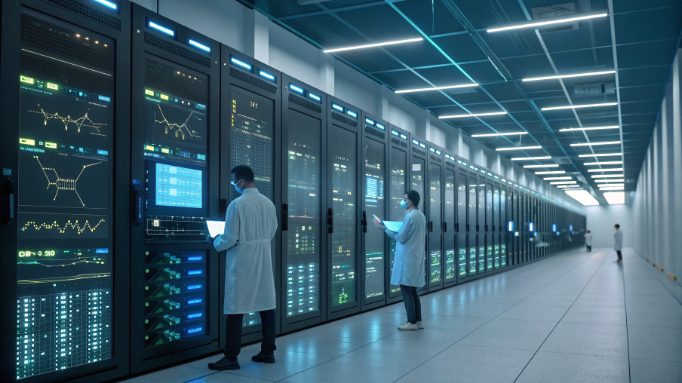How Hong Kong Servers Optimize Facial Recognition System

The integration of facial recognition systems with Hong Kong server infrastructure has revolutionized AI application performance. This technological synergy leverages Hong Kong’s strategic location and advanced network capabilities to deliver unprecedented efficiency in facial recognition processing. As organizations increasingly adopt AI-driven solutions, the demand for high-performance computing infrastructure continues to grow exponentially.
Strategic Advantages of Hong Kong Servers
Hong Kong’s position as a global technology hub provides distinct advantages for hosting facial recognition systems. The region’s sophisticated digital infrastructure creates an ideal environment for AI applications that require ultra-low latency and high reliability.
- Geographic proximity to major Asian markets, enabling faster data transmission and processing
- Advanced fiber optic infrastructure with redundant international connections
- Sub-20ms latency to key Asian cities, ensuring real-time processing capabilities
- 99.99% uptime guarantee through enterprise-grade facilities
- Robust power infrastructure with multiple redundancy levels
- Advanced cooling systems optimized for high-density computing
Core Requirements for Facial Recognition Systems
Modern facial recognition applications demand specific server configurations to maintain optimal performance. These requirements have evolved significantly as the technology has matured and become more sophisticated.
- Real-time processing capabilities:
- Minimum 30 frames per second processing
- Support for multiple concurrent video streams
- Real-time feature extraction and matching
- Memory requirements:
- High-bandwidth memory configurations
- Optimized memory channels for AI workloads
- Advanced caching mechanisms
- GPU specifications:
- Enterprise-grade GPU acceleration
- Dedicated deep learning processors
- Multi-GPU scaling capabilities
- Network infrastructure:
- High-bandwidth network interfaces
- Advanced traffic management
- Quality of Service (QoS) optimization
Hardware Configuration Optimization
Optimal hardware configuration is crucial for maximizing facial recognition system performance. The following components require careful consideration and tuning:
- CPU Selection:
- Latest-generation enterprise processors
- Multi-core architecture optimization
- Advanced vector processing capabilities
- Thermal efficiency considerations
- GPU Implementation:
- Enterprise-class GPU configurations
- Scalable multi-GPU architectures
- Advanced cooling solutions
- Power delivery optimization
- Storage Architecture:
- NVMe storage arrays
- Tiered storage implementation
- I/O optimization techniques
Architectural Optimization Strategies
A well-designed distributed architecture is fundamental to achieving maximum system efficiency. Modern facial recognition systems benefit from the following architectural approaches:
- Load Balancing:
- Dynamic workload distribution
- Automatic failover mechanisms
- Geographic load distribution
- Caching Implementation:
- Multi-layer caching strategy
- Distributed cache coherency
- Cache warming mechanisms
- Microservices Architecture:
- Containerized application components
- Service mesh implementation
- API gateway optimization
Implementation Steps
Successful deployment requires a systematic approach to implementation:
- Infrastructure Preparation:
- Rack optimization for thermal efficiency
- Network topology design and implementation
- Power distribution planning and redundancy
- Software Deployment:
- Container orchestration setup
- Database optimization and sharding
- Monitoring system implementation
- Performance Tuning:
- System parameter optimization
- Network throughput adjustment
- Resource allocation fine-tuning
Security Implementation
Security measures are paramount for facial recognition systems, requiring comprehensive protection at multiple levels:
- Data Protection:
- End-to-end encryption protocols
- Secure data transmission channels
- Privacy-preserving computing techniques
- Access Control:
- Role-based access management
- Multi-factor authentication
- Audit logging and monitoring
- Compliance:
- Regular security assessments
- Regulatory compliance monitoring
- Policy enforcement mechanisms
Future Perspectives
The evolution of Hong Kong’s server infrastructure continues to push the boundaries of facial recognition capabilities:
- Emerging Technologies:
- Quantum computing integration potential
- Advanced AI acceleration hardware
- Next-generation networking protocols
- Efficiency Improvements:
- Enhanced power efficiency solutions
- Advanced cooling technologies
- Automated optimization systems
The optimization of facial recognition systems through Hong Kong’s server infrastructure represents a significant leap forward in AI application deployment. By leveraging strategic advantages and implementing cutting-edge technologies, organizations can achieve unprecedented levels of performance and reliability. As technology continues to evolve, Hong Kong’s server facilities remain at the forefront of innovation in facial recognition system optimization.

